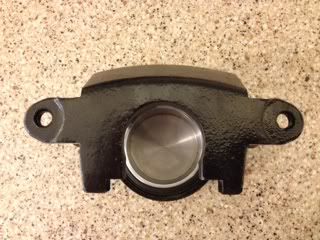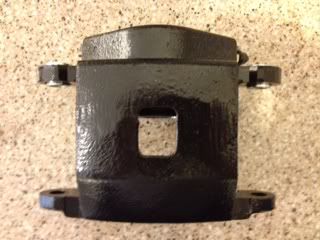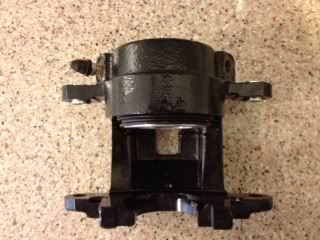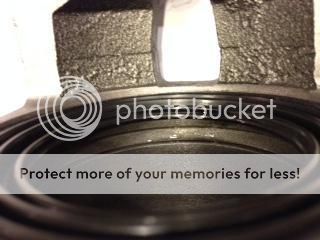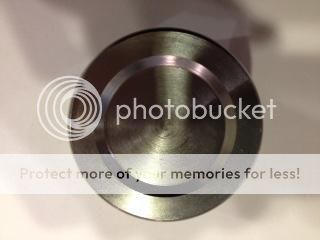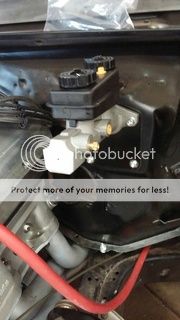I just finished up upgrading the brakes on my father’s 1980 El Camino. This is a daily driver that I am testing several different master cylinders for a manual brake conversion swap. His brakes worked good before exchanging out all the parts, but I wanted to take out most of the variables when testing master cylinders. First and foremost, I wanted to make sure this 1980 El Camino did not have quick take up front brake calipers. In my research, quick take up calipers will make it difficult do get good pressure to the caliper when using manual brakes.
Here is the rundown of the parts I used:
• Speedway Motors Big Bore Metric Calipers - PN# 91031040 $59.99 each
• Bendix Titanium metallic front brake pads (FF Rated) - PN# MKD154 $38.22
• Turned the stock rotors $30 Local Auto Parts Store $15 each
• Edelbrock/Russel Stainless Steel Braided Flex Lines PN# 692100 $54.80
• Wagner 7/8” Wheel Cylinders from an manual brake S10 PN# F110261 $13 each
• Wagner Thermo Quiet Rear Shoes (EE Rated) - PAB514R from O’Reilly’s Auto $32.99
The Speedway Motors big bore metric calipers (2.75” bore v 2.38” bore standard) came with brake pads, but the pads did not have a rating on them. I DID NOT want to use a brake pad that would need a lot of heat to be effective. The weight difference between the two calipers is less than ½ of a pound. This is a daily driver and not an autocross car, so I chose the Bendix Titanium pads because my research and reviews showed them to have good cold clamping friction. Based on the EE rating, the rear shoes should also have good cold stopping abilities. Look on the pads or shoes when you buy them to make sure they have a rating on them. The higher up the alphabet you go the hotter the pads will have to be to work effectively. Pads or shoes with no rating on them should be avoided.
It was surprising to me to find a 24mm strait bore aluminum master cylinder on this 1980 El Camino. I didn’t know they made aluminum ones with a strait bore for g-bodies. I had always been under the impression, because it was aluminum, that this was a step bore master for quick take up calipers. I do know for a fact that any NEW replacement master cylinders for g-bodies will for than likely be cast iron. So if you want aluminum master cylinder for power or manual brakes that bolt up to your brake lines, a rebuilt master cylinder may be your only option.
I changed out the 30 year old rubber brake lines with the braided stainless. The front lines were a little longer than the originals, but I routed them so they were not touching any suspension pieces. The rear was a little more difficult to replace because the clip that holds the rubber line to the frame was difficult to get at. The new braided rear line was fairly easy to install also.
The hardest part to the entire swap was installing the rear wheel cylinders. Getting the clip off was not too bad, but getting the clip back on was a pain. I did it with two c-clamp, and open ended wrench, and the lid off of an old battery terminal cleaner (don’t ask for these details because I do not recommend doing it this way. G-H-E-T-T-O).
After the system install, bleeding the fluids, and bedding in the pads and shoes I took it out for a spin to test the brakes with the same master cylinder and vacuum booster from the original test with the original brakes. Even though I was able to easily lock up all four wheels, it seems to have a little more pedal travel before you could feel the brakes start to grab. I believe this has to do with the increased piston area in the front calipers and rear wheel cylinders while using the strait bore 24mm master cylinder. The 24mm master cylinder will have more pedal travel to fill the extra volume of fluid required by the calipers and wheel cylinders.
If keeping the vacuum booster, it might be best to step up to the step bore master cylinders that are used on the 1981 and up g-bodies. The primary bore is still 24mm, but it also has a larger step bore of 36mm that will increase the volume of fluid to the larger calipers and wheel cylinders.
Here is the rundown of the parts I used:
• Speedway Motors Big Bore Metric Calipers - PN# 91031040 $59.99 each
• Bendix Titanium metallic front brake pads (FF Rated) - PN# MKD154 $38.22
• Turned the stock rotors $30 Local Auto Parts Store $15 each
• Edelbrock/Russel Stainless Steel Braided Flex Lines PN# 692100 $54.80
• Wagner 7/8” Wheel Cylinders from an manual brake S10 PN# F110261 $13 each
• Wagner Thermo Quiet Rear Shoes (EE Rated) - PAB514R from O’Reilly’s Auto $32.99
The Speedway Motors big bore metric calipers (2.75” bore v 2.38” bore standard) came with brake pads, but the pads did not have a rating on them. I DID NOT want to use a brake pad that would need a lot of heat to be effective. The weight difference between the two calipers is less than ½ of a pound. This is a daily driver and not an autocross car, so I chose the Bendix Titanium pads because my research and reviews showed them to have good cold clamping friction. Based on the EE rating, the rear shoes should also have good cold stopping abilities. Look on the pads or shoes when you buy them to make sure they have a rating on them. The higher up the alphabet you go the hotter the pads will have to be to work effectively. Pads or shoes with no rating on them should be avoided.
It was surprising to me to find a 24mm strait bore aluminum master cylinder on this 1980 El Camino. I didn’t know they made aluminum ones with a strait bore for g-bodies. I had always been under the impression, because it was aluminum, that this was a step bore master for quick take up calipers. I do know for a fact that any NEW replacement master cylinders for g-bodies will for than likely be cast iron. So if you want aluminum master cylinder for power or manual brakes that bolt up to your brake lines, a rebuilt master cylinder may be your only option.
I changed out the 30 year old rubber brake lines with the braided stainless. The front lines were a little longer than the originals, but I routed them so they were not touching any suspension pieces. The rear was a little more difficult to replace because the clip that holds the rubber line to the frame was difficult to get at. The new braided rear line was fairly easy to install also.
The hardest part to the entire swap was installing the rear wheel cylinders. Getting the clip off was not too bad, but getting the clip back on was a pain. I did it with two c-clamp, and open ended wrench, and the lid off of an old battery terminal cleaner (don’t ask for these details because I do not recommend doing it this way. G-H-E-T-T-O).
After the system install, bleeding the fluids, and bedding in the pads and shoes I took it out for a spin to test the brakes with the same master cylinder and vacuum booster from the original test with the original brakes. Even though I was able to easily lock up all four wheels, it seems to have a little more pedal travel before you could feel the brakes start to grab. I believe this has to do with the increased piston area in the front calipers and rear wheel cylinders while using the strait bore 24mm master cylinder. The 24mm master cylinder will have more pedal travel to fill the extra volume of fluid required by the calipers and wheel cylinders.
If keeping the vacuum booster, it might be best to step up to the step bore master cylinders that are used on the 1981 and up g-bodies. The primary bore is still 24mm, but it also has a larger step bore of 36mm that will increase the volume of fluid to the larger calipers and wheel cylinders.












